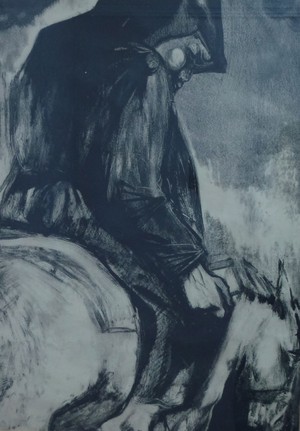'The Seven Deadly Sins and The Devil Unmasked' by Gavin Alston, circa 1962-3
8 large Monotypes of the 'Seven Deadly Sins and the Devil' based on Spencer's The Faerie Queene.





















Gavin Alston created this most impressive set of monotypes for his exhibition at The Grail Gallery in 1963, prior to his death. For me they represent the summit of his work. They are, in my opinion, the most 'contemporary' i.e. seem to show the influence of Robert Colquhoun and Graham Sutherland, contemporaneous artists. Strong draughtsmanship, emotional intensity and imaginative composition are fused successfully in this powerful series of works.
Gavin based his imagery for the Seven Deadly Sins on Edmund Spencer's 'The Faerie Queene' ( first published in 1590). In Spencer's work the Seven Deadly Sins are personified by actual people, who ride on animals that mirror their character types. Pride, Queen Lucifera, is the leader and the rest are her attendants or counsellors.
'Sluggish Idleness' rides on a 'slothfull Asse', 'Loathsome Glutton' rides on a 'filthe swine', 'Lustful Lecherie' rides on a 'bearded Goat', 'Greedy Auerice' on a 'Camel loaded all with gold', 'Malicious Enuie' on a 'ravenous wolfe' and 'Revenging Wrath' rides on a 'Lion, loth for to be led'.
From an article from 'The Scotsman, May 20th, 1963'
Art in Scotland
GAVIN ALSTON
Show of religious works
By Sydney Goodsir Smith
'The Grail Book and Art Centre, 36 George Street, is a welcome new addition to the small number of private galleries in Edinburgh. Its present exhibition is of religious paintings, drawings and prints by Gavin Alston and a most impressive show it is.
Mr Alston divides his work into three sections, of which the eight monotypes on the theme of ‘The Seven Deadly Sins’ is by far the most important, though his six unframed, ink drawings of The Last Supper are most striking and effective. The monotypes of the ‘Seven Deadly Sins and the Devil’ (who drives the team) are extremely powerful and imaginative creations. Gavin Alston’s work is bold incisive and strongly emotional in its impact. The Teutonic influence of Breughel and Bosch, is paramount, but absorbed and digested.
Among his few paintings here, there is a vigorous, dramatic Crucifixion, but the four oils forming an incomplete series of the Plagues of Egypt are much less impressive. Colour, for some reason, weakens his work, as does the medium of oil paint. His strength lies in line, in boldness of gesture and silhouette. His talent is a public one, I would say, and he likes to work on a large scale. It is not surprising that his drawings have been used to illustrate a series of religious programmes on STV. They are also on show but they pale beside his splendid monotypes.
Mr Alston certainly has a future – undoubtedly, he has a present.'
Document Actions